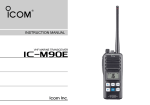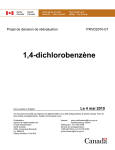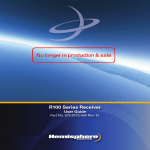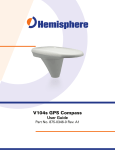Download Icom IGM1600 Two-Way Radio User Manual
Transcript
INSTRUCTION MANUAL SURVIVAL CRAFT 2-WAY RADIO iGM1600 This device complies with Part 15 of the FCC Rules. Operation is subject to the condition that this device does not cause harmful interference. SAFETY TRAINING INFORMATION Your Icom radio generates RF electromagnetic energy during transmit mode. This radio has been evaluated for compliance at the distance of 2.5 cm with the FCC RF exposure limits for “Occupational Use Only”. In addition, your Icom radio complies with the folW ARN ING lowing Standards and Guidelines with regard to RF energy and electromagnetic energy levels and evaluation of such levels for exposure to humans: • FCC OET Bulletin 65 Edition 97-01 Supplement C, Evaluating Compliance with FCC Guidelines for Human Exposure to Radio Frequency Electromagnetic Fields. • American National Standards Institute (C95.1-1992), IEEE Standard for Safety Levels with Respect to Human Exposure to Radio Frequency Electromagnetic Fields, 3 kHz to 300 GHz. • American National Standards Institute (C95.3-1992), IEEE Recommended Practice for the Measurement of Potentially Hazardous Electromagnetic Fields– RF and Microwave. • The following accessories are authorized for use with this product. Use of accessories other than those specified may result in RF exposure levels exceeding the FCC requirements for wireless RF exposure.; Belt Clip (MB-86, MB-103Y), Rechargeable Ni-Cd Battery Pack (BP-224) and Lithium Battery Pack (BP-234). To ensure that your expose to RF electromagnetic energy is within the FCC allowable limits for occupational use, always adhere to the following guidelines: C AU TIO N i • DO NOT operate the radio without a proper antenna attached, as this may damage the radio and may exceed FCC RF exposure limits. A proper antenna is the antenna supplied with this radio by the manufacturer or an antenna specifically authorized by the manufacturer for use with this radio. • DO NOT transmit for more than 50% of total radio use time (“50% duty cycle”). Transmitting more than 50% of the time can cause FCC RF exposure compliance requirements to be exceeded. The radio is transmitting when the “TX indicator” light is red. You can cause the radio to transmit by pressing the “PTT” switch or VOX function. • ALWAYS keep the antenna at least 2.5 cm (1 inch) away from the body when transmitting and only use the Icom belt-clips which are listed on page 26 when attaching the radio to your belt, etc., to ensure FCC RF exposure compliance requirements are not exceeded.To provide the recipients of your transmission the best sound quality, hold the radio in an almost vertical position at least 5 cm (2 inches) from your mouth, the microphone is located next to the speaker, so you should “talk into the speaker”. The information listed above provides the user with the information needed to make him or her aware of RF exposure, and what to do to assure that this radio operates within FCC RF exposure limits. Electromagnetic Interference/Compatibility During transmissions, your Icom radio generates RF energy that can possibly cause interference with other devices or systems. To avoid such interference, turn off the radio in areas where signs are posted to do so. DO NOT operate the transmitter in areas that are sensitive to electromagnetic radiation such as hospitals, aircraft, and blasting sites. RECOMMENDATION FOREWORD CLEAN THE TRANSCEIVER THOROUGHLY WITH FRESH WATER after exposure to saltwater, and dry it before operation. Otherwise, the transceiver’s keys, switches and controllers may become inoperable due to salt crystallization. Thank you for purchasing this Icom radio. The IC-GM1600 SURVIVAL CRAFT 2-WAY RADIO is designed and built with Icom’s state of the art technology and craftsmanship. With proper care, this product should provide you with years of trouble-free operation. NOTE: DO NOT remove the battery pack when cleaning the transceiver thoroughly with fresh water. Water may enter into the transceiver, and damage it. IMPORTANT READ ALL INSTRUCTIONS carefully and com- pletely before using the transceiver. SAVE THIS INSTRUCTION MANUAL—This instruction manual contains important operating instructions for the IC-GM1600. EXPLICIT DEFINITIONS MIC /SP WORD DEFINITION Personal injury, fire hazard or electric shock RWARNING may occur. CAUTION NOTE Equipment damage may occur. If disregarded, inconvenience only. No risk of personal injury, fire or electric shock. ii PRECAUTION RWARNING! NEVER connect the transceiver to an AC outlet. This may pose a fire hazard or result in an electric shock. RWARNING! NEVER hold the transceiver so that the antenna is closer than 2.5 cm (1 inch) from exposed parts of the body, especially the face or eyes, while transmitting. The transceiver will perform best if the microphone is 5 to 10 cm (2 to 4 inches) away from the lips and the transceiver is vertical. MAKE SURE the flexible antenna and battery pack are securely attached to the transceiver, and that the antenna and battery pack are dry before attachment. Exposing the inside of the transceiver to water will result in serious damage to the transceiver. For U.S.A. only CAUTION: Changes or modifications to this device, not expressly approved by Icom Inc., could void your authority to operate this device under FCC regulations. NEVER connect the transceiver to a power source other than the BP-224 or BP-234. Such a connection will ruin the transceiver. AVOID using or placing the transceiver in direct sunlight or in areas with temperatures below –20°C (–4°F) or above +60°C (+140°F) for U.S.A. version;.–20°C (–4°F) or above +55°C (+131°F) for General version KEEP the transceiver out of the reach of children. KEEP the transceiver at least 0.9 meters (3.0 ft) away from your vessel’s magnetic navigation compass. Icom, Icom Inc. and the logo are registered trademarks of Icom Incorporated (Japan) in the United States, the United Kingdom, Germany, France, Spain, Russia and/or other countries. iii TABLE OF CONTENTS SAFETY TRAINING INFORMATION ............................................... i RECOMMENDATION ...................................................................... ii FOREWORD ................................................................................... ii IMPORTANT .................................................................................... ii EXPLICIT DEFINITIONS ................................................................. ii PRECAUTION ................................................................................ iii TABLE OF CONTENTS .................................................................. iv 1 OPERATING RULES ................................................................. 1 2 SUPPLIED ACCESSORIES AND ATTACHMENTS ............... 2–3 ■ Supplied accessories ............................................................... 2 ■ Attachments ............................................................................. 2 3 PANEL DESCRIPTION .......................................................... 4–6 ■ Front, top and side panels ....................................................... 4 ■ Function display ...................................................................... 5 4 BASIC OPERATION ............................................................ 7–10 ■ Channel selection ................................................................... 7 ■ Receiving and transmitting ...................................................... 8 ■ Call channel programming ...................................................... 9 ■ Adjusting the squelch level ..................................................... 9 ■ Lock function ......................................................................... 10 ■ Signal strength indicator function .......................................... 10 ■ Monitor function .................................................................... 10 ■ Backlighting function ............................................................. 10 ■ VOX function (FOR ON-BOARD USE ONLY) ...................... 10 5 SET MODE ......................................................................... 11–15 ■ SET mode programming ....................................................... 11 ■ SET mode items ................................................................... 12 6 BP-234 BATTERY PACK ......................................................... 16 7 BATTERY CHARGING (FOR ON-BOARD USE ONLY) .... 17–20 ■ Battery charging .................................................................... 17 ■ Battery cautions .................................................................... 17 ■ Optional battery chargers ...................................................... 19 8 OPTIONAL SWIVEL BELT CLIP ............................................. 21 ■ MB-86 contents ..................................................................... 21 ■ Attachment ............................................................................ 21 ■ Detachment ........................................................................... 21 9 OPTIONAL SPEAKER-MICROPHONE (FOR ON-BOARD USE ONLY) ................................................ 22 ■ HM-125 descriptions ............................................................. 22 ■ Attachment ............................................................................ 22 10 CHANNEL LIST FOR SURVIVAL OPERATION....................... 23 1 2 3 4 5 6 7 8 9 10 11 12 13 11 TROUBLESHOOTING ............................................................. 24 12 SPECIFICATIONS .................................................................... 25 13 OPTIONS ................................................................................. 26 iv 1 OPERATING RULES D Priorities • Read all rules and regulations pertaining to priorities and keep an up-to-date copy handy. Safety and distress calls take priority over all others. • You must monitor Channel 16 when you are not operating on another channel. (2) OPERATOR’S LICENSE A restricted Radiotelephone Operator Permit is the license most often held by small vessel radio operators when a radio is not required for safety purposes. The Restricted Radiotelephone Operator Permit must be posted near the transceiver or be kept with the operator. Only a licensed radio operator may operate a transceiver. • False or fraudulent distress calls are prohibited under law. D Privacy • Information overheard but not intended for you cannot lawfully be used in any way. • Indecent or profane language is prohibited. D Radio licenses (1) SHIP STATION LICENSE When your craft is equipped with a VHF FM transceiver, you must have a current radio station license before using the transceiver. It is unlawful to operate a ship station which is not licensed. Inquire through your dealer or the appropriate government agency for a Ship-Radiotelephone license. This license includes the call sign which is your craft’s identification for radio purposes. 1 However, non-licensed individuals may talk over a transceiver if a licensed operator starts, supervises, ends the call and makes the necessary log entries. A current copy of the applicable government rules and regulations is only required to be on hand for vessels in which a radio telephone is compulsory. However, even if you are not required to have these on hand it is your responsibility to be thoroughly acquainted with all pertinent rules and regulations. SUPPLIED ACCESSORIES AND ATTACHMENTS ■ Supplied accessories ■ Attachments The following accessories are supplied: Qty. q Handstrap . . . . . . . . . . . . . . . . . . . . . . . . . . . . . . . . . . . . 1 w Battery charger (BC-158) . . . . . . . . . . . . . . . . . . . . . . . . 1 e Belt clip (MB-103Y) . . . . . . . . . . . . . . . . . . . . . . . . . . . . 1 r AC adapter (BC-147A/E)* . . . . . . . . . . . . . . . . . . . . . . . 1 t Ni-Cd battery pack (BP-224) . . . . . . . . . . . . . . . . . . . . . 1 D Handstrap 2 1 2 Pass the handstrap through the loop on the top of the transceiver as illustrated at right. Facilitates carrying. *Depends on versions. q w e CHG D Belt clip Attach the belt clip to the transceiver as illustrated below. r t Supplied screws 2 2 SUPPLIED ACCESSORIES AND ATTACHMENTS ï Battery pack To remove the battery pack: Turn the screw counterclockwise, then pull the battery pack in the direction of the arrow as shown below. NOTE: When removing or attaching the battery pack, use a coin or flat-blade screwdriver to loosen or tighten the bottom screw. To attach the battery pack: Insert the battery pack in the IC-GM1600 completely, then turn the screw clockwise. CAUTION!: When attaching or removing a battery pack, make sure the rubber seal is set in the groove of the battery pack correctly. If the seal is not neatly in the groove it may be damaged when attaching the battery pack. If the seal is damaged, waterproofing is not guaranteed. NEVER remove or insert the battery pack when the transceiver is wet or soiled. This may result water or dust getting into the transceiver/battery pack and may result in the transceiver being damaged. NOTE: When the lock screw does not easily turn (feels tight), check to ensure the battery pack is sufficiently inserted to the transceiver. DO NOT bang or cause high impact to the battery pack, as this may damage the battery pack/or the transceiver. When attaching a battery pack, make sure dust or else does not adhere to the rubber seal. If dust or anything else is on the seal when attaching a battery pack, the water resistant seal may be compromised. Make sure both the rubber seal (purple) is set into the groove correctly and dust or else does not adhere to it. LO CK Screw position when removing battery NOTE: OPEN Screw position when attaching battery Incorrect position Correct position LO CK Rubber seal OPEN Groove Battery pack 3 Battery pack PANEL DESCRIPTION 3 ■ Front, top and side panels w q MIC/SP e r q VOLUME CONTROL [VOL] Turns power ON and adjusts the audio level. 2 3 w MICROPHONE CONNECTOR [MIC/SP] Connects the optional external microphone. NOTE: Attach the [MIC/SP] cap when the optional speaker-microphone is not used. e ANTENNA Fixed type. !1 r TRANSMIT/RECEIVE INDICATOR Lights green while receiving a signal or when the squelch is open; lights red while transmitting (lights orange while VOX function is used). !0 t CALL CHANNEL KEY [CALL] ➥ Selects the call channel when pushed. (p. 7) t y o i u • Channel 9* is factory default. *Channel 16 is set as factory default by version. ➥ Push for 3 sec. to enter call channel programming condition. (p. 9) y CHANNEL KEY [CH] Push to return the previous condition when distress channel or call channel is selected. (p. 7) u TRANSMIT POWER/LOCK KEY [Hi/Lo• ] ➥ Selects high or low power when pushed. (p. 8) ➥ Toggles the lock function ON/OFF when pushed for 1 sec. (p. 10) 4 3 PANEL DESCRIPTION ■ Function display i CHANNEL 16 KEY [16] Selects Channel 16 when pushed. (p. 7) q w e r t Y]/[Z Z] o CHANNEL UP/DOWN KEYS [Y ➥ Selects an operating channel. (pgs. 7–8) ➥ Selects the SET mode condition of the item. (p. 11) ➥ Selects the SET mode item when pushed with [SQL]. (p. 11) !0 SQUELCH SWITCH [SQL•MONI] ➥ Push this switch, then adjust the squelch level with Y]/[Z Z]. (p. 9) [Y ➥ Manually opens the squelch for monitoring the channel while pushed and held. (p. 10) ➥ While pushing this switch, turn power ON to enter the SET mode. (p. 11) !1 PTT SWITCH [PTT] Push and hold to transmit; release to receive. y !0 o i q SIGNAL STRENGTH INDICATOR (pgs. 10, 14) Shows the relative signal strength while receiving signals. w TRANSMIT POWER INDICATOR (p. 8) ➥ “LOW” appears when low power is selected. ➥ No indication appears when high power is selected. e SQUELCH LEVEL INDICATOR (p. 9) Shows the squelch level. r MONITOR INDICATOR (p. 10) Appears when the monitor function is activated. 5 u PANEL DESCRIPTION t BATTERY INDICATOR Indicates remaining battery power. o CHANNEL NUMBER READOUT ➥ Indicates the selected operating channel number. ➥ In SET mode, indicates the selected condition. Using rechargeable battery pack 3 !0 CALL CHANNEL INDICATOR Appears when the call channel is selected. (p. 7) Indication Battery level 3 Full Middle Charging required No battery blinks when the battery is over charged. Using BP-234 battery pack Indication Battery level Full Middle A new battery pack is required No battery y VOX INDICATOR “VOX” appears when the VOX function is used. (p. 10) u SET MODE ITEM READOUT Indicates the SET mode items while in the SET mode. (p. 11) i LOCK INDICATOR Appears when the lock function is activated. (p. 10) 6 4 BASIC OPERATION ■ Channel selection D Channel 16 D Call channel Channel 16 (Distress channel) is used for establishing initial contact with another station and for emergency communications. While standing by, you must monitor Channel 16. The call channels can be re-programmed (p. 9) and may be used to store your most often used channels for quick recall. q Push [CALL] to select the call channel. q Push [16] to select Channel 16. w Push [CH] to return to the condition before selecting Channel 16, or push [Y]/[Z] to select the operating channel. • “CALL” and the call channel number appear. • Call channel can be re-programmed. See the “Call channel programming” on p. 9 for details. w Push [CH] to return to the condition before selecting the call channel, or push [Y]/[Z] to select the operating channel. Push Push 7 BASIC OPERATION 4 ■ Receiving and transmitting q Rotate [VOL] clockwise to turn power ON. w Set the volume and squelch level. ➥ Push [SQL•MONI], and push [√] to open the squelch. ➥ Push [SQL•MONI] to stop the “SQL” indicator blinking, then rotate [VOL] to set the volume level. ➥ Push [SQL•MONI], and push [∫]/[√] to set the squelch level. e Push [Y]/[Z] to select the desired channel. - When receiving a signal, the [TRANSMIT/RECEIVE] indicator lights green while audio is emitted from the speaker. - Further adjustment of [VOL] may be necessary at this point. r Push [Hi/Lo• ] to select the output power if necessary. - “LOW” appears when low power is selected; no indication when high power is selected. - Choose low power to conserve battery power, choose high power for longer distance communications. - Some channels are for low power only. IMPORTANT: To maximize the readability of your transmitted signal, pause a moment after pushing [PTT], hold the microphone 5 to 10 cm (2 to 4 inches) from your mouth and speak into the microphone at a normal voice level. 4 NOTE: The transceiver has a power save function to conserve the battery power. The power save function activates automatically when no signal is received for 5 sec. For U.S.A version: To prevent accidental prolonged transmission, etc., the IC-GM1600 has a time-out-timer function. The timer cuts a transmission OFF after 5 min. of continuous transmission. t Push to transmit y Release to receive MIC/SP t Push and hold [PTT] to transmit, then speak into the microphone. - The [TRANSMIT/RECEIVE] indicator lights red while q Power ON w Set volume Speaker transmitting. y Release [PTT] to receive. Microphone w Set the squelch level w Set the squelch level e Select channel r Select output power 8 4 BASIC OPERATION ■ Call channel programming ■ Adjusting the squelch level The call channel switch is used to select Channel 9* by default, however, you can program your most often-used channel for quick recall. To adjust the IC-GM1600’s squelch level, use the [Y]/[Z] keys. In order to receive signals properly, the squelch must be adjusted to the proper level. *The channel number depends on version. q Push [CALL] to select the call channel. • “CALL” and call channel number appear. w Push [CALL] again for 3 sec. (until a long beep changes to 2 short beeps) to enter call channel programming condition. • Call channel number to be programmed flashes. e Push [Y]/[Z] to select the desired channel. r Push [CALL] to program the displayed channel as the call channel. • The call channel number stops flashing. 9 q Push [SQL•MONI], then adjust the squelch level with [Y]/[Z]. - “SQL” indicator starts blinking. - There are 11 squelch levels to choose from: OP is completely open; 10 is tight squelch; 1 is loose squelch level. w Push [SQL•MONI] again to return to normal condition. - When no switch is pushed for 5 sec., the transceiver returns to normal condition. Blinks during the squelch level adjutment. Push Indicates the squelch level. BASIC OPERATION 4 ■ Lock function ■ Monitor function This function electronically locks all keys (except for [PTT], [SQL•MONI] and [Hi/Lo• ]) to prevent accidental channel changes and function access. ➥ Push [Hi/Lo• ] for 1 sec. to turn the lock function ON and OFF. The monitor function releases the noise squelch mute to check the volume level. See p. 12 for details of the monitor switch action. ➥ Push [SQL•MONI] for 1 sec. and keep holding to activate the monitor function. ” appears and audio is emitted. ■ Backlighting function Push This function is convenient for nighttime operation. The backlighting brightness can be adjusted in the SET mode. (p. 12) ➥ Push any key except for [PTT] to turn the backlighting ON. for 1 sec. Appears while the lock function is used. ■ Signal strength indicator The received signal strength level is indicated by number of bars as below. • Only the antenna mark appears when receiving no signal or a very weak signal when the signal strength indicator is set to ON in the SET mode (p. 14). • This indicator can be hidden by using the SET mode (p. 14) if desired. Indication Signal strength •“ 4 Strong Middle Weak No signal or Very weak • The backlighting is automatically turned OFF after 5 sec. of inactivity. ■ VOX function (FOR ON-BOARD USE ONLY) The VOX function (voice operated transmission) starts transmission without pushing [PTT] when you speak into the microphone; then automatically returns to receive when you stop speaking (hands-free operation becomes possible). NOTE: An optional headset and headset adapter (OPC1392) is required for the VOX operation. ➥ Push and hold [SQL•MONI], then push [Hi/Lo• ] to turn the VOX function ON/OFF while connecting the optional headset and headset adapter to the [MIC/SP] connector. • “VOX” appears on the LCD while the VOX function is ON. • The “VOX gain” and “VOX delay” can be set in the SET mode. (pgs. 14 and 15) 10 5 SET MODE ■ SET mode programming SET mode is used to change the condition of 11 transceiver functions: beep tone function, monitor switch action, backlighting function, LCD contrast selection, auto power save function, self check function, battery voltage indicator, signal strength indicator, squelch sensitivity function, VOX gain* and VOX delay*. *Available for on-board use only. D SET mode operation q Turn power OFF. w While pushing [SQL•MONI], turn power ON to enter the SET mode. • “bp” (Beep tone function setting) appears. e Push [SQL•MONI] or [SQL•MONI] and [Y]/[Z] to select the desired item, if necessary. r Push [Y]/[Z] to select the desired condition of the item. t Push [16] to exit the SET mode. D SET MODE ITEMS The displays show the default settings, and the selected item is displayed in the dotted circle. VOX gain* Squelch sensitivity VOX delay* Beep tone *Available for on-board use only : Push Signal strength indicator 11 Battery voltage Starting item Push : Push Monitor switch Backlighting LCD contrast and and Self check Auto power save SET MODE 5 ■ SET mode items D Beep tone function “bP” D Backlighting function “bL” You can select silent operation by turning the beep tones OFF, or you can have 2 types of confirmation beeps sound at the push of a key. When “ON” is selected, a fixed beep (Pi) sounds, and when “US” is selected, the preset beeps (e.g. do, re, mi) sound. This function is convenient for nighttime operation. The backlighting brightness can be adjusted from OFF, 1 (dark)–3 (bright); 3 (default). Select 1–3 to turn this function ON. • Beep tone synchronizes with the volume level. • The beeps sound during call channel programming even if this function is turned OFF. • The automatic backlighting turns the backlighting ON when any switch except for [PTT] is pushed. • The backlighting is automatically turned OFF after 5 sec. of inactivity. 5 Push Push Beep tone ON (default) Beep tone OFF D Monitor switch action “Sq” The monitor switch action cuts off the squelch function temporarily. This switch action contains PUSH (Pu) or HOLD (Ho) settings as shown below. • PU (PUSH): After pushing [SQL•MONI] for 1 sec., the squelch opens and emits audio. The squelch is held open while continuously pushing and holding [SQL•MONI]. (default) • HO (HOLD): After pushing [SQL•MONI] for 1 sec., the squelch opens and emits audio even if [SQL•MONI] is released. To close the squelch, push any switch. Backlighting ON (default) Backlighting OFF D LCD contrast selection “LC” The contrast of the LCD can be adjusted from 4 levels. • 1 (bright)–4 (dark); 3 (default) Push Middle contrast (default) Low contrast Push PUSH setting (default) HOLD setting 12 5 SET MODE D Auto power save function “PS” D Self check function “SC” The auto power save function reduces battery drain by deactivating the receiver circuit for preset intervals. The self check function checks the transceiver conditions by itself, and informs you in case a problem is found. Self check automatically and quickly runs through its diagnostic steps each time the radio is turned ON. Afterwards, the radio switches to normal operation mode. • ON : The power save function is turned ON. The power save function will activate when no signal is received, and no operation is performed for 5 sec. • OFF: The power save function is turned OFF. • Temperature : Outside of –35°C to +80°C; –31°F to +173°F (approx.) • Connected battery voltage Push Power save ON (default) Push Power save OFF Self check OFF (default) Self check ON When error messages as shown below are displayed, see troubleshooting for advice. (p. 24) Temperature error 13 Battery voltage error SET MODE 5 D Battery voltage indicator “bt” D Squelch sensitivity function “SS” This function controls display or non-display settings of the connected battery pack’s voltage when the power is ON. When this function is turned ON, blocking against noise is improved. Therefore the squelch is not easily affected by noise. • The voltage of the connected battery pack is displayed for 2 sec. after power is turned ON. 5 Push Push Battery voltage indicator OFF (default) Squelch sensitivity OFF (default) Squelch sensitivity ON Battery voltage indicator ON D Signal strength indicator “Sl” The signal strength indicator displays received signal strength like an “S-meter”. This function is convenient to check the signal strength visually. D VOX gain “ga” (Available for on-board use only) Adjusts the VOX gain level (from 1 to 6) when speaking into the optional headset. • Setting the VOX gain to 1 increases the sensitivity. • Setting the VOX gain to 6 reduces the sensitivity. • The strength is displayed at 4 steps. • The antenna mark and 3 bars appear when receiving strong signals. • The antenna mark only appears when receiving no signal when the signal strength indicator is ON. Push VOX gain 3 (default) VOX gain 6 Push Signal strength indicator OFF (default) Signal strength indicator ON 14 5 SET MODE D VOX delay “dL” (Available for on-board use only) Sets the VOX delay timer (0.5 to 3.0 sec. in 0.5 sec. steps) keeping the radio in transmit mode after you stop speaking. • Setting the delay to 0.5 (0.5 sec.) is a short VOX delay. • Setting the delay to 3.0 (3.0 sec.) is a long VOX delay. Push VOX delay 1.0 (default) VOX delay 3.0 SET MODE LIST Function Indication Condition Beep tone function “bP” OFF/ON*/US Monitor switch action “Sq” PUSH*/HOLD Backlighting function “bL” OFF/1/2/3* LCD contrast selection “LC” 1/2/3*/4 Auto power save function “PS” OFF/ON* Self check function “SC” OFF*/ON Battery voltage indicator “bt” OFF*/ON Signal strength indicator “SI” OFF*/ON Squelch sensitivity “SS” OFF*/ON VOX gain “ga” 1/2/3*/4/5/6 VOX delay “dL” 0.5/1.0*/1.5/2.0/2.5/3.0 *default setting 15 BP-234 BATTERY PACK The optional BP-234 battery pack is a non-rechargeable, Lithium battery pack for operation in a survival craft. The following precaution must be observed. • NEVER dispose of the BP-234 battery pack in a fire. This could result in an explosion. • DO NOT short-circuit the BP-234 battery pack. Metal contact (such as paper clip, another battery, etc.) across the battery contacts can result in a sustained high rate discharge, which could damage the battery, void the warranty and create a burn or a fire hazard. 6 • DO NOT apply excessive pressure to the battery. This may result in electrolyte leakage, possibly causing an explosion. • The storage life of the BP-234 is about 5 years. Once the expiration date on the battery pack passes, a new battery pack must be purchased. • For safety reasons, once the BP-234 is used, a spare one should be purchased. The original battery pack can be continued to be used for regular communications; save the spare one for emergency situations. 5 6 • NEVER expose of the BP-234 battery pack to excessive heat of 60°C (+140°F) or above. This could result in electrolyte leakage, possibly causing an explosion or fire. • NEVER attempt to recharge the BP-234. Lithium batteries may explode or cause a fire in such cases. • BP-234 Lithium battery pack • DO NOT disassemble the BP-234 battery pack. The BP-234 battery pack contains no user serviceable parts. Internal battery gas can cause throat irritation. Also, exposed lithium may generate heat and ignite. IMPORTANT! • This battery pack is for EMERGENCY USE ONLY. • Store at temperatures below +35°C (+95°F). • Once this bag’s seal is broken, a new emergency battery pack must be used for EMERGENCY use. 16 7 BATTERY CHARGING (FOR ON-BOARD USE ONLY) ■ Battery charging ■ Battery cautions Prior to using the transceiver for the first time, the battery pack must be fully charged for optimum life and operation. CAUTION! NEVER insert a battery pack or a transceiver (with the battery pack attached) that is wet or soiled into the charger. This may result in corrosion of the charger terminals or damage to the charger. The charger is not waterproof and water can easily get into it. CAUTION: To avoid damage to the transceiver, turn the power OFF while charging. • Recommended temperature range for charging: +10°C to +40°C (+50°F to +104°F) • Use the specified chargers (BC-158, BC-119N and BC-121N). NEVER use another manufacture’s charger. • Use the supplied AC adapter for the BC-158. NEVER use another manufacture’s adapters. D Recycling information The product that you have purchased contains a rechargeable battery. The battery is recyclable. At the end of its life, under various state and local laws, it may be illegal to dispose of this battery into the municipal waste stream. Call 1-800822-8837 for battery recycling options in your area or contact your dealer. Turn the transceiver OFF when charging an attached battery pack. Otherwise, the battery pack may not become fullcharging or may not charge properly. 17 NEVER incinerate used battery packs. Internal battery gas may cause an explosion. NEVER immerse a battery pack in water. If the battery pack becomes wet, be sure to wipe it dry immediately (particularly the battery terminals), and especially BEFORE attaching it to the transceiver. NEVER short terminals of the battery pack. Also, current may flow into nearby metal objects, such as a necklace, etc. Those may cause burn, electric shock or fire. Therefore, be careful when carrying in a pocket, backpack or handbag, and when placing the radio near metal objects. If your battery pack seems to have no capacity even after being charged, completely discharge it by leaving the power ON overnight. Then, fully charge the battery pack again. If the battery still do not retain a charge (or very little), a new battery pack must be replaced. BATTERY CHARGING (FOR ON-BOARD USE ONLY) 7 ï Charging connections q Attach the BC-158 to a flat surface, such as a desk. w Connect the AC adapter as shown below. e Insert the battery pack with/without the transceiver into the charger. • The charge indicator lights green. r Charge the battery pack approx. 8 hours, depending on the remaining power condition. DO NOT charge the BP-224 more than 12 hours. Otherwise, the BP-224 will be damaged. 7 Turn power OFF MIC/SP BP-224 IC-GM1600 Charge indicator Lights green when the BP-224 (with/without IC-GM1600) is inserted. Supplied screws AC adapter* BC-158 *Plug type is dependent on version. 18 7 BATTERY CHARGING (FOR ON-BOARD USE ONLY) ■ Optional battery chargers ï AD-109 installation q Connect the charger’s 10-pin connector to the AD-109 desktop charger adapter’s plug. NOTE: BE CAREFUL not to catch the unused 3-pin plug between the charger and the charger adapter. NOTE: The 3-pin connector is not used. Supplied screws Desktop charger adapter 10-pin connector Not used (3-pin connector) Plug 19 w Install the adapter into the charger in the direction of the arrow, then use the supplied 2 screws to attach the charger adapter to the charger. BATTERY CHARGING (FOR ON-BOARD USE ONLY) 7 ï Rapid charging with the BC-119N+AD-109 ï Rapid charging with the BC-121N+AD-109 The optional BC-119N provides rapid charging of battery packs. The following are additionally required. • AD-109 charger adapter • An AC adapter (BC-145A/E)*1 or the DC power cable (OPC-515L/CP-17L). The optional BC-121N allows up to 6 battery packs to be charged simultaneously. The following are additionally required. • Six AD-109 charger adapters • An AC adapter (BC-124) or the DC power cable (OPC-656) *1Depends on version. IC-GM1600 7 Turn power OFF MIC/SP Turn power OFF IC-GM1600 BP-224 MIC/SP BP-224 *Plug type is dependent on version. AC adapter* (Purchase separately) AD-109 charger adapters are installed in each slot. AD-109 charger adapter is installed in BC-119N. AC adapter*2 *2Plug type is dependent on version. Optional OPC-515L (for 13.8 V power source) or CP-17L (for 12 V cigarette lighter socket) can be used instead of the AC adapter. DC power cable (OPC-656) (Connect with the DC power supply; 13.8 V/at least 7 A) 20 8 OPTIONAL SWIVEL BELT CLIP ■ MB-86 contents e Once the transceiver is locked in place, it swivels as illustrated below. Qty. Belt clip ………………………………………………………… 1 Base clip ……………………………………………………… 1 Supplied screws ……………………………………………… 2 ■ Attachment q Screw the base clip to the back of the transceiver using the two screws (supplied) as shown below. Supplied screws ■ Detachment ➥ Turn the transceiver upside down in the direction of the arrow and pull out from the belt clip. w Clip the belt clip over your belt and insert the transceiver. R CAUTION! HOLD THE TRANSCEIVER TIGHTLY, WHEN HANGING OR DETACHING THE TRANSCEIVER FROM THE BELT CLIP. Otherwise the transceiver may not be attached to the belt clip or swivelled properly attached to the belt clip and may not swivel properly. The transceiver could then be accidentally dropped and scratched or damaged . 21 OPTIONAL SPEAKER-MICROPHONE (FOR ON-BOARD USE ONLY) ■ HM-125 descriptions Alligator-type clip To attach the speaker-mic. to your shirt or collar, etc. PTT switch Transmits when push. Receives when release. Microphone Speaker NEVER immerse the connector in water without connecting with the transceiver. If the connector becomes wet, be sure to dry BEFORE connecting it to the transceiver. NOTE: The microphone is located at the top of the speaker-microphone, as shown in the diagram above. To maximize the readability of your transmitted signal (voice), hold the microphone approx. 2.5 cm (1 inch) from your mouth, and speak in a normal voice level. 9 ■ Attachment Insert the speaker-mic connector onto [MIC/SP] connector and carefully screw it tight, as shown in the diagram below. Be careful not to cross thread the connection. Set the triangle mark to the front side. Detaching: Pull up the cap in the direction of the arrow to detach it. Attaching: Attach the cap in the direction of the arrow completely. 8 9 CAUTION: Attach the speaker-microphone’s connector securely to prevent accidental dropping, or water intrusion into the connector. IMPORTANT: KEEP the transceiver’s [MIC/SP] connector cap attached when the speaker-microphone is not in use. Water will not get into the transceiver even if the cover is not attached, however, the terminals (pins) will become rusty, or the transceiver will function abnormally if the connector has become wet. 22 10 CHANNEL LIST FOR SURVIVAL OPERATION Channel number TX/RX Channel number TX/RX Channel number TX/RX 06 156.300 MHz 08 156.400 MHz 09 156.450 MHz 10 156.500 MHz 11 156.550 MHz 12 156.600 MHz 13 156.650 MHz 14 156.700 MHz 15* 156.750 MHz 16 156.800 MHz 17* 156.850 MHz 67 156.375 MHz 68 156.425 MHz 69 156.475 MHz 71 156.575 MHz 72 156.625 MHz 73 156.675 MHz 74 156.725 MHz 77 156.875 MHz *U.S.A. version is low power only 23 TROUBLESHOOTING PROBLEM POSSIBLE CAUSE SOLUTION The transceiver does • The battery is exhausted. not turn ON. • Change to a new battery pack (Survival). • Recharge the battery pack (On-board). • Bad connection to the battery pack. No sound from the • Squelch level is too deep. speaker. • Volume level is too low. • Speaker has been exposed to water. • Water has entered the [MIC/SP] connector. Transmitting is impos- • Some channels are for low power or resible, or high power ceive only. can not be selected. • The battery is exhausted. • Check the connection to the transceiver. • Set squelch to the threshold point. • Rotate [VOL] to set a suitable level. • Drain water from the speaker. • Dry [MIC/SP] connector. • Change channels. • Change to a new battery pack (Survival). • Recharge the battery pack (On-board). • Push [Hi/Lo• ] to select high power. • Push [Hi/Lo• ] for 1 sec. to cancel the function. • Set the beep tones to ON (Fix Beep/User Beep) on the SET mode. • The temperature is outside of –35°C to • Leave the transceiver at room temperature Self check error. +80°C; –31°F to +173°F (approx.). for a while. Turn the power ON to check if the (Temperature) internal temperature has returned to normal. • The connected battery pack’s voltage is • Verify the battery voltage is correct. Self check error. more than 11 V. (Battery voltage) • Remove the headset cable. Transmitting continu- • Ambient noise is too loud. • Reduce the VOX gain setting. ously while not speaking when using VOX function. • The output power is set to low. The displayed channel • Lock function is activated. cannot be changed. • Beep tones are turned OFF. No beeps. 11 REF. p. 16 pgs. 17–20 p. 3 p. 9 p. 8 — — pgs. 8, 23 p. 16 pgs. 17–20 p. 8 p. 10 10 11 p. 12 — — p. 14 24 12 SPECIFICATIONS D GENERAL • Frequency coverage TX/RX • Mode • Channel spacing • Power supply requirement • Current drain (approx.) at 7.5 V DC for [USA] at 7.2 V DC for [GEN] • Useable temperature range [USA] [GEN] • Antenna impedance • Dimensions (Projections not included) • Weight (with BP-234) : 156.300–156.875 MHz : 16K0G3E : 25 kHz : Battery packs (BP-234 or BP224*) *For on-board use only : TX High (2 W) 1.0 A TX Low (1 W) 700 mA Max. audio 200 mA : –20°C to +60°C; –4°F to +140°F –20°C to +55°C; –4°F to +131°F : 50 Ω : 65(W) × 145(H) × 44(D) mm 29/16(W) × 523/32(H) × 13/4(D) inch : Approx. 385 g (13.6 oz) D TRANSMITTER • Output power at 7.5 V DC for [USA] at 7.2 V DC for [GEN] • Modulation system • Frequency error [USA] [GEN] • Microphone impedance • Max. frequency deviation • Adjacent channel power • Audio harmonics distortion • FM hum and noise 25 : 2 W (Hi) and 1 W (Low) : Variable reactance frequency modulation : ±5.0 ppm (–20°C to +60°C; –4°F to +140°F) ±1.5 kHz (–20°C to +55°C; –4°F to +131°F) : 2 kΩ : ±5.0 kHz : 70 dB : 10% at 60% deviation : 40 dB • Spurious emissions [USA] [GEN] : –70 dBc typical 0.25 µW (30 MHz to 1 GHz) 1 µW (1–2 GHz) D RECEIVER • Receive system • Sensitivity [USA] (at 12 dB SINAD) [GEN] (at 20 dB SINAD) • Squelch sensitivity (at threshold) [USA] [GEN] • Intermodulation rejection ratio [USA] [GEN] • Spurious response rejection ratio • Adjacent channel selectivity • Hum and noise • Audio output power [USA] [GEN] : Double-conversion superheterodyne : 0.25 µV typical –2 dBµ EMF typical : 0.35 µV typical 0 dBµ EMF typical : 70 dB 68 dB : 70 dB : 70 dB : 40 dB : 0.35 W typical at 10% distortion with an 8 Ω load. 0.20 W at 10% distortion with an 8 Ω load. All stated specifications are subject to change without notice or obligation. OPTIONS 13 D BATTERY PACKS D CHARGERS <FOR ON-BOARD USE ONLY> <FOR SURVIVAL CRAFT USE> • BP-234 LITHIUM BATTERY PACK 9.0 V/3300 mAh Lithium battery pack. <FOR ON-BOARD USE> • BP-224 Ni-Cd BATTERY PACK 7.2 V/750 mAh Ni-Cd battery pack. • BP-225 Ni-Cd BATTERY PACK 7.2 V/1100 mAh Ni-Cd battery pack. • BC-119N DESKTOP CHARGER + AD-109 CHARGER ADAPTER + BC-145A/E* AC ADAPTER For rapid charging of battery packs. An AC adapter is supplied with the charger depending on versions. Charging time: approx. 1.5 to 2 hours (BP-224). • BC-121N MULTI-CHARGER + AD-109 CHARGER ADAPTER (6 pcs.) + BC-124 AC ADAPTER For rapid charging of up to 6 battery packs (six AD-109 are required) simultaneously. An AC adapter should be purchased separately. Charging time: approx. 1.5 to 2 hours (BP-224). • BC-158 DESKTOP CHARGER + BC-147A/E* AC ADAPTER Used for regular charging of battery pack. The same as supplied with the transceiver. Charging time: approx. 8 hours (BP-224). *The supplied AC adapter is dependent on version. D BELT CLIPS • MB-103Y BELT CLIP The same as supplied with the transceiver. • MB-86 SWIVEL BELT CLIP Belt clip for swivel type. • MB-96F/96N BELT HANGER ➥MB-96F: Attaches with the supplied belt clip (Not swivel type). ➥MB-96N: Belt hanger for swivel type. D OTHER OPTIONS <FOR ON-BOARD USE ONLY> • HM-125 SPEAKER-MICROPHONE Full sized waterproof (IPX7; 1 m; 3 ft depth for 30 min.) speaker-microphone. Includes an alligator clip to attach the speaker mic to your shirt or collar, etc. • HS-94/HS-95/HS-97 HEADSET + OPC-1392 HEADSET ADAPTER HS-94: Ear-piece type HS-95: Neck-arm type HS-97: Throat microphone D DC CABLES <FOR ON-BOARD USE ONLY> • CP-17L CIGARETTE LIGHTER CABLE Charges the battery pack through a 12 V cigarette lighter socket. (For BC-119N) • OPC-515L/OPC-656 DC POWER CABLES Charges the battery pack using 13.8 V power source instead of the AC adapter. OPC-515L: For BC-119N OPC-656 : For BC-121N 12 13 Different versions of this radio use different options. Ask your authorized dealers for details. 26 A-6383D-1EX Printed in Japan © 2004 Icom Inc. 1-1-32 Kamiminami, Hirano-ku, Osaka 547-0003, Japan









































